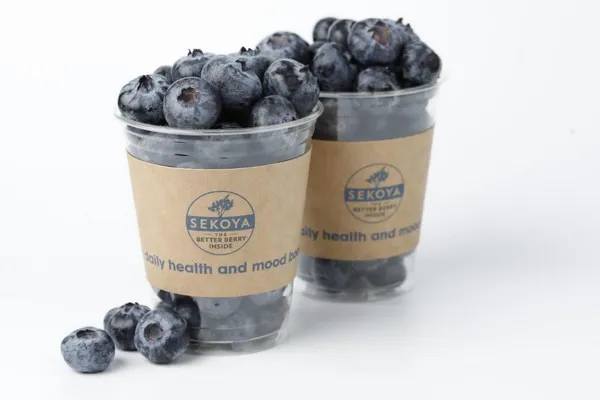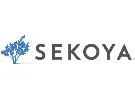In recent years, the consumption, production and global trade of blueberries have done nothing but grow. This is evidenced by Faostat data from the last two decades and corroborated by multiple international studies, which unanimously agree that the sector and per capita consumption will continue to increase significantly worldwide in the coming years.
The product category, backed by such relevant projections, is, in fact, already big enough for the sector to take a step further in creating value with new levels of differentiation, and that is the goal of the Sekoya® B2B brand platform.

Sekoya Pop ‘FCM14-052’.
"As a specialist in strong brand marketing, and seeing that, without a strong brand, the size of the blueberry category in the Netherlands is already equal to 75% of the Red Bull category, I believe that there is such an opportunity. The key criterion for branded fruit is to never let the consumer down, so you need a consistent quality (a Chiquita banana or a Pink Lady apple always delivers what is expected of them). Through research, we know that more than 50% of consumer experiences with blueberries today are negative, and less than 25% of consumer experiences align with consumer preferences. The main issue is fruit firmness, which is why Sekoya is focused on offering a consistent quality, with a crunchy texture and a long shelf life," says Hans Liekens, Sekoya's Value Chain & Retail Manager.

"Sekoya is the first platform to offer a 52-week supply program of crunchy, long-lasting, flavorful blueberries with consistent quality. Most other programs are focused on the Southern Highbush/Low-Zero Chill (varieties grown mainly in Spain, Morocco, Peru...) and some of them on the Northern Highbush/Mid-High Chill (varieties grown in Poland, Central Europe, North America, Chile...), and in order to offer 52 weeks of consistency, we combine both. Sekoya has 2 varieties for Low Chill (Sekoya Pop FCM14-052 and Sekoya Beauty FCM12-097) and 2 varieties for High Chill (Sekoya Crunch FC13-083 and Sekoya Grande FC13-122).
Outstanding firmness and caliber
Both factors, in addition to their flavor, are the most outstanding characteristics of the new Sekoya varieties, according to Hans, who expects them to drive the momentum of consumption growth in this category. "We know that only 20% of the European population eats blueberries, so 80% have yet to discover them. If we ask consumers (users and non-users), more than 75% prefer larger blueberries, so we need larger caliber fruit to attract new consumers to the category."
Sekoya Pop FCM14-052.
"The fruit being soft leads to waste in supermarkets (and dissatisfied consumers, which in turn leads to lower repeat purchases), so the best way to get the category and its shelf space to grow is to reduce waste throughout the value chain by supplying firmer fruit with a longer shelf life."
14 highly professional licensee members
Sekoya is focusing its activity in 3 key consumer markets: the United States-Canada, Europe and China, supplying its premium fruit through a semi-exclusive network of 14 highly professional licensee members (growers/marketers), organized and managed to deliver already defined volumes to all markets.
"We create a very flexible business environment for our retail customers. Chains can choose between 14 potential suppliers for the same fruit. Most produce in 4-6 countries, so supermarkets can source according to their needs (with local/national production, organic...)."
"As for the production itself, we see that most Sekoya members are looking for sub-licensees to better respond to supermarkets' needs (local production) or to complete their 52-week supply. If there are growers interested in growing Sekoya, we pass their presentation and details to the 14 members and they decide whether or not to contact the potential member."
Sekoya Beauty FCM12-097.
"In this regard, Huelva is and will remain an interesting area for the cultivation of blueberries. It should be noted that this Spanish province is the growing area that is closest to the European consumer. There is the risk of everyone planting fruit with the same genetic characteristics, which could lead to oversupply in the short term and the business becoming less attractive. Also, we cannot ignore the competition from other regions, which will continue to grow, but by planting varieties with the best genetic characteristics close to the consumer, the commercial advantages are great, including the supply of local products and a reduced carbon footprint. Also, COVID showed us that some supermarkets are willing to buy their products as close to home as possible."
"In both cases, supermarkets or growers interested in our project can contact Sekoya members directly or contact me as Value Chain & Retail Manager," says Hans.
Blueberry consumption could double in the next 7 years
Global blueberry consumption is expected to increase in the coming years. "In fact, data shows that we are globally consuming about 1 million tons of blueberries today, and within 7 years, this amount will increase to 2 million tons. With the new Sekoya® Genetics we can enter a new and much larger category than the current breakfast category: the snacking category. Did you know that the global snacking category is 4 times larger than the breakfast category ($1,450 billion vs. $398 billion)?" says Hans. "Today, in Europe, most blueberries are consumed at breakfast. With larger, crunchier and ready-to-eat berries, blueberries have the potential to become a healthy alternative for modern consumers in the fast-growing on-the-go category."
 For more information:
For more information:
Hans Liekens
Sekoya Value Chain & Retail Manager
Tel.: +32 477 531 529
hansl@sekoyafruit.com
https://sekoyafruit.com
